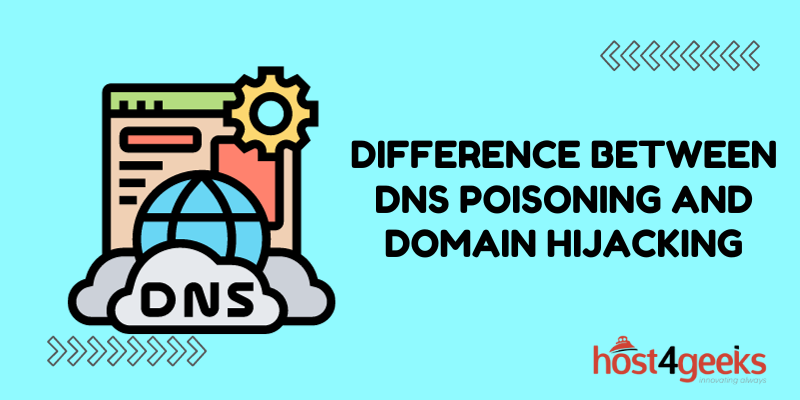In the intricate web of cybersecurity, understanding the nuances between DNS poisoning and domain hijacking is paramount. As businesses and individuals alike navigate the digital landscape, safeguarding online assets is of utmost importance.
DNS poisoning involves the corruption of the domain name system, leading unsuspecting users to malicious websites, while domain hijacking entails the unauthorized transfer of domain ownership, often resulting in significant financial and reputational consequences.
In this comprehensive guide, we delve into the depths of these threats, shedding light on their mechanisms, potential impacts, and, most importantly, effective prevention measures.
Whether you’re a tech enthusiast or a business owner, equipping yourself with knowledge about these distinct yet perilous attacks is the first step toward a more secure online presence.
Understanding DNS Poisoning
What is DNS Poisoning?
DNS (Domain Name System) poisoning, also known as DNS spoofing or cache poisoning, is a malicious act wherein the DNS records of a domain are manipulated. The aim is to redirect users attempting to access a legitimate website to a malicious or fraudulent website.
This is achieved by altering the DNS cache of a DNS server, making it point to an incorrect IP address.
How Does DNS Poisoning Work?
In DNS poisoning attacks, cybercriminals exploit vulnerabilities in DNS servers to inject false information into their caches. When a user tries to access a website, their device consults a DNS server to resolve the domain name into an IP address.
If the DNS cache has been poisoned, the user is directed to the attacker’s server instead of the legitimate server, exposing them to potential cyber threats.
Consequences of DNS Poisoning
The consequences of falling victim to DNS poisoning can be severe. Users might unknowingly provide sensitive information to attackers, resulting in identity theft, financial losses, or unauthorized access to confidential data. Moreover, businesses can suffer reputational damage due to their involvement in spreading malicious content.
Decoding Domain Hijacking
What is Domain Hijacking?
Domain hijacking also referred to as domain theft, involves unauthorized access to a domain owner’s account credentials to manipulate domain settings. Attackers gain control over the domain, allowing them to alter DNS records, transfer ownership, or redirect traffic to malicious websites.
Methods of Domain Hijacking
Domain hijacking can occur through various methods, including social engineering, phishing attacks, or exploiting vulnerabilities in domain registrar systems. Attackers may impersonate domain owners, manipulate support staff, or use malware to gain access to crucial account information.
Impact of Domain Hijacking
The repercussions of domain hijacking can be devastating. A hijacked domain can lead to loss of website traffic, compromised customer trust, and financial harm. In some cases, hijackers hold domains ransom, demanding a hefty payment for their release, causing financial strain and disrupting business operations.
Key Differences Between DNS Poisoning and Domain Hijacking
Nature of Attack
DNS poisoning primarily targets the DNS infrastructure itself. It aims to manipulate the DNS cache to misdirect users to malicious websites. On the other hand, domain hijacking involves unauthorized access to domain ownership accounts, allowing attackers to control domain settings.
Point of Entry
DNS poisoning exploits vulnerabilities in DNS servers or intermediary systems, altering the DNS resolution process. Domain hijacking, however, typically occurs by compromising domain registrar accounts through social engineering or phishing.
Target and Impact
DNS poisoning targets users trying to access a specific domain, redirecting them to malicious websites. Domain hijacking, on the other hand, involves taking over the entire domain, impacting its accessibility, ownership, and reputation.
Protecting Against DNS Poisoning and Domain Hijacking
DNS Security Measures
To guard against DNS poisoning, it’s essential to implement DNSSEC (DNS Security Extensions) to authenticate DNS responses and prevent unauthorized alterations to DNS records. Regularly updating and patching DNS software can also minimize vulnerabilities.
Domain Protection Strategies
Mitigating domain hijacking requires adopting stringent security practices. Enable two-factor authentication (2FA) for domain registrar accounts, maintain up-to-date contact information, and regularly monitor domain settings for any unauthorized changes.
Conclusion
In today’s digital age, safeguarding your online presence against cyber threats is non-negotiable. Understanding the fundamental differences between DNS poisoning and domain hijacking is the first step toward effective protection.
By implementing robust security measures, such as DNSSEC and 2FA, you can fortify your defenses and thwart malicious actors from compromising your digital assets. Remember, knowledge is power – and in the realm of cybersecurity, it’s your best defense.

